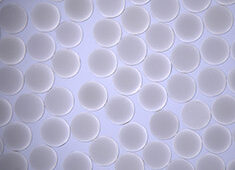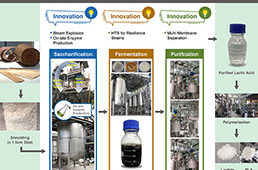
a) This is a photograph of the spherical colloidal crystals containing 0.20 wt% carbon black (CB). The size of the fine silica particles ranges from 200 to 300 nm, and 11 different sizes were used. b) This is a picture of a weevil drawn using spherical colloidal crystals prepared using monodispersed silica particles with various particle sizes and CB. The surroundings of the weevils are drawn with spherical colloidal crystals that do not contain CB and change with the color of the background. Credit: John Wiley & Sons, Inc.
Researchers have developed a material where different layers of cells with different properties combine to enable it to change colors.
A team from Nagoya University in Japan has created a composite material that, when its composition is adjusted and exposed to different types of light, can mimic changes in color similar to how animals like chameleons, octopuses and frogs change color in response to changes in the environment.
“This is an exciting stage in this field of study, as we are increasingly able to adapt the color-changing mechanisms that some animals use to artificial devices,” study first author Miki Sakai said in a statement. “If these artificial color-changing materials can equal or surpass the vibrant displays that some animals such as octopuses and frogs make, it could have exciting applications in the development of new display technologies.”
The new material is comprised of dyes and crystals that change the color and patterns it displays depending on the background color used within it and its exposure to visible or ultraviolet light.
Each component of the new material is crucial to its color-changing properties. The dyes contribute their inherent colors to the overall appearance of the material, which ultimately can be adjusted by mixing them to different extents. The dyes also change color when exposed to light.
The spherical crystals also influence the color through their microscopic structures that directly interfere with light.
In addition, a black pigment and different background colors were used to alter the colors the other components of the system display.
“We examined the influences of the different components in the system, such as by changing the size of the crystals, switching the background from white to black, or performing exposure to visible or ultraviolet light,” corresponding author Yukikazu Takeoka said in a statement. “We found these changes resulted in different colors being displayed across the material, resembling the way in which some organisms can change color in response to various factors in their environment.”
The researchers still need a better understanding on how animals change color to properly translate it into useful applications.
The study was published in Small.




